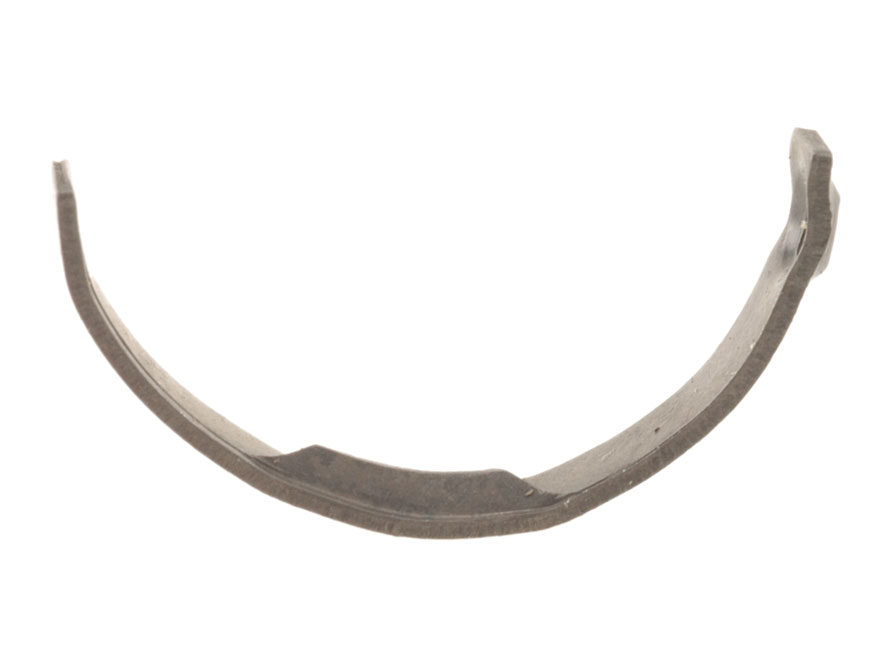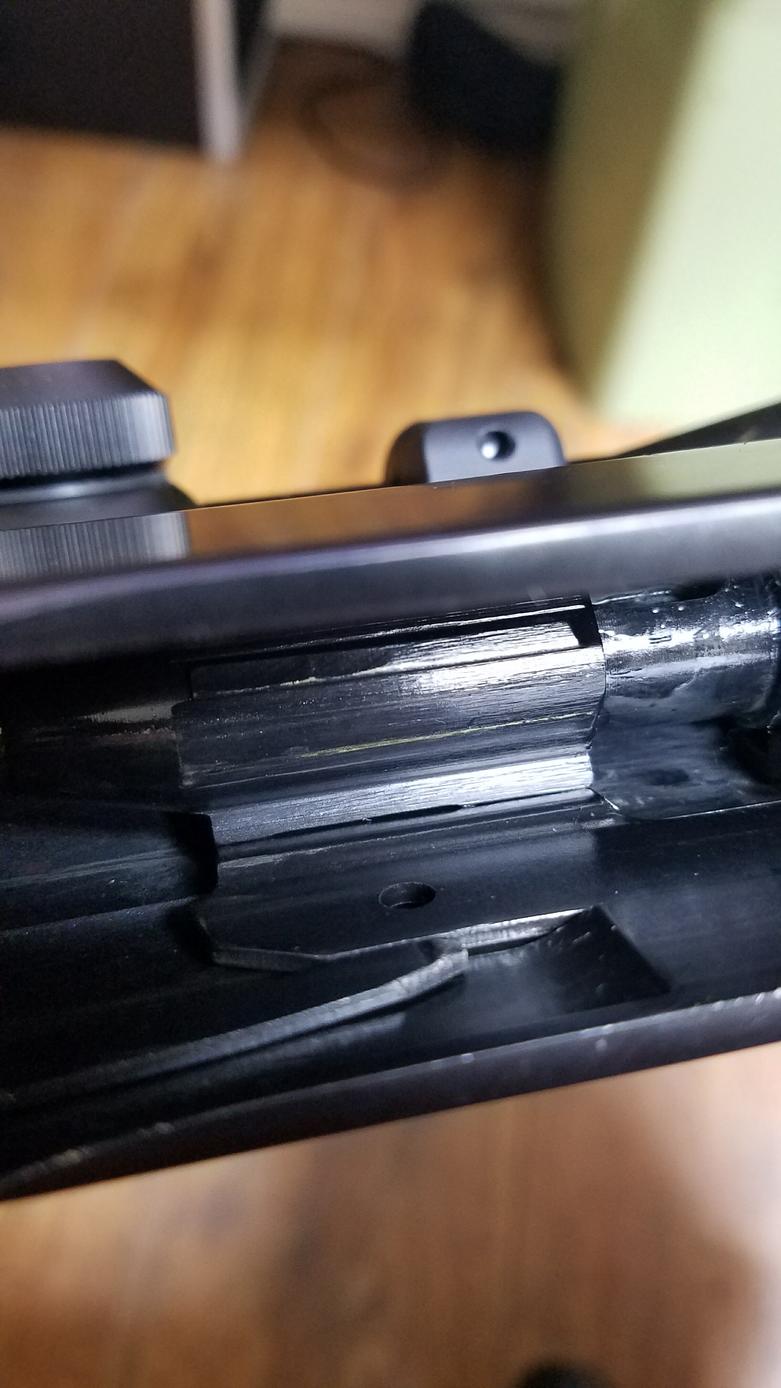Remington 7600 jams, stiff action by mr texaco
I,ve seen some questions about the 7600. I have one in 35 Whelen, here is what I found:
Stiff action, jamming . . . The action bar assembly part no #91560 is held in battery by the action bar lock lever part no #91432. This lever is released from the lock position when the trigger is pulled. This lever is also used to release the action from battery manually without pulling the trigger. The action bar lock bears on the left side slide rail and rides along the underside of the slide rail when the action is pumped. It returns to the lock position when the slide is moved forward, and the gun goes into battery. The "stiff" action or jamming occurs when the lock lever slips off of the slide rail and becomes trapped between the slide rail and the frame. This causes the slide action to bind up when moving rearward. The fix . . . (do not try this unless you are competent). Remove magazine and make safe. With the slide forward and trigger cocked, look into the magazine well and observe the slide rail where it meets the lock lever. Rock the slide side-to-side and observe the gap between the frame and the slide rail. It should be less than 1/2 the thickness of the lock lever. Observe the position of the lock lever. The forward lock lever surface should be slightly away from the frame guide slot as it bears on the center of slide rail edge. In my case, the lock lever was up against the frame, and there was a significant gap between the slide rail and the frame, large enough to allow the lock lever to slip off the slide rail and jam the gun. This is what I did. (refer the problem to a competent gunsmith if you cannot perform this work . . . My fix may not be the only way to address this problem)
Dissasemble the gun, soft vice the action bar assembly and spread the rear portion of the left slide rail in small increments until it rides in the slot with only a small gap between it and the the frame. Soft vice the lock lever and bend the front 1/3 gently until it no longer bears against the frame. Be careful! Use only a slight bending motion. Reassemble the gun and check for proper operation. The lock lever should ride on the center of the slide rail edge.
Difficulty going into battery. 1.) If you are crimping the brass into the cannelure of your hand loads, make sure that the crimping force does not bell the brass. 2.) Clean the bolt lugs thoroughly and scrub with a bronze brush. Lubricate the bolt lugs with a light coat of lithium based (white) grease. The lugs will "polish in" the more you shoot the gun. Insert a nonmarring cleaning rod into the barrel from the muzzle end. When it clears the chamber insert a 45 cal brush and screw it onto the rod. Use a slow speed drill to slowly rotate the brush while pulling it into the chamber. Brush the chamber with gun solvent. Do not pull the brush into the bore. Remove the brush, then remove the cleaning rod. Rinse the chamber and barrel. Clean and reassemble the gun.
Hi All,
I read a post about a 7600 that would not go into batery or took excessive force to get it into battery when chambering a round. This may help. The 7600 uses a "circular" half moon extractor ring inside the bolt face. When the bolt is worked forward, the shell is chambered and the cartridge rim expands the ectractor ring which allows the cartridge rim to recess into the bolt face while going into battery. If the cartridge rim hangs up on the extractor ring and it does not expand, the gun will not go into battery. On inspection, I found that the rounds were hanging on the edge of the extractor ring. The fix:: Order a new extractor ring from Brownells. (The extractor ring should not be reused once removed) Carefully break the edge of the new extractor in the area of the ectractor claw. I used a diamond dremmel and then Flitz polish to smooth this area. Install new extractor ring. This significantly eased the force needed to put the gun in battery. As always, do not attempt unless you are competent.

My Remington 7600 35 Whelen now functions flawlessly.
Attached Thumbnails



several members of my group own these remington, 7600 /whelen rifles
the 7600 in caliber 35 whelen is very popular and well respected in my group of elk hunters,
especially when loaded with the speer 250 grain bullet and several common powders,
55 grains imr 4320 powder,and a 215 fed primer is preferred by many guys.
55 grains ,imr 4064 powder of powder and a 215 fed primers, is a marginally a bit slower
but also accurate
I,ve seen some questions about the 7600. I have one in 35 Whelen, here is what I found:
Stiff action, jamming . . . The action bar assembly part no #91560 is held in battery by the action bar lock lever part no #91432. This lever is released from the lock position when the trigger is pulled. This lever is also used to release the action from battery manually without pulling the trigger. The action bar lock bears on the left side slide rail and rides along the underside of the slide rail when the action is pumped. It returns to the lock position when the slide is moved forward, and the gun goes into battery. The "stiff" action or jamming occurs when the lock lever slips off of the slide rail and becomes trapped between the slide rail and the frame. This causes the slide action to bind up when moving rearward. The fix . . . (do not try this unless you are competent). Remove magazine and make safe. With the slide forward and trigger cocked, look into the magazine well and observe the slide rail where it meets the lock lever. Rock the slide side-to-side and observe the gap between the frame and the slide rail. It should be less than 1/2 the thickness of the lock lever. Observe the position of the lock lever. The forward lock lever surface should be slightly away from the frame guide slot as it bears on the center of slide rail edge. In my case, the lock lever was up against the frame, and there was a significant gap between the slide rail and the frame, large enough to allow the lock lever to slip off the slide rail and jam the gun. This is what I did. (refer the problem to a competent gunsmith if you cannot perform this work . . . My fix may not be the only way to address this problem)
Dissasemble the gun, soft vice the action bar assembly and spread the rear portion of the left slide rail in small increments until it rides in the slot with only a small gap between it and the the frame. Soft vice the lock lever and bend the front 1/3 gently until it no longer bears against the frame. Be careful! Use only a slight bending motion. Reassemble the gun and check for proper operation. The lock lever should ride on the center of the slide rail edge.
Difficulty going into battery. 1.) If you are crimping the brass into the cannelure of your hand loads, make sure that the crimping force does not bell the brass. 2.) Clean the bolt lugs thoroughly and scrub with a bronze brush. Lubricate the bolt lugs with a light coat of lithium based (white) grease. The lugs will "polish in" the more you shoot the gun. Insert a nonmarring cleaning rod into the barrel from the muzzle end. When it clears the chamber insert a 45 cal brush and screw it onto the rod. Use a slow speed drill to slowly rotate the brush while pulling it into the chamber. Brush the chamber with gun solvent. Do not pull the brush into the bore. Remove the brush, then remove the cleaning rod. Rinse the chamber and barrel. Clean and reassemble the gun.
Hi All,
I read a post about a 7600 that would not go into batery or took excessive force to get it into battery when chambering a round. This may help. The 7600 uses a "circular" half moon extractor ring inside the bolt face. When the bolt is worked forward, the shell is chambered and the cartridge rim expands the ectractor ring which allows the cartridge rim to recess into the bolt face while going into battery. If the cartridge rim hangs up on the extractor ring and it does not expand, the gun will not go into battery. On inspection, I found that the rounds were hanging on the edge of the extractor ring. The fix:: Order a new extractor ring from Brownells. (The extractor ring should not be reused once removed) Carefully break the edge of the new extractor in the area of the ectractor claw. I used a diamond dremmel and then Flitz polish to smooth this area. Install new extractor ring. This significantly eased the force needed to put the gun in battery. As always, do not attempt unless you are competent.

My Remington 7600 35 Whelen now functions flawlessly.
Attached Thumbnails




several members of my group own these remington, 7600 /whelen rifles
the 7600 in caliber 35 whelen is very popular and well respected in my group of elk hunters,
especially when loaded with the speer 250 grain bullet and several common powders,
55 grains imr 4320 powder,and a 215 fed primer is preferred by many guys.
55 grains ,imr 4064 powder of powder and a 215 fed primers, is a marginally a bit slower
but also accurate
Last edited:


